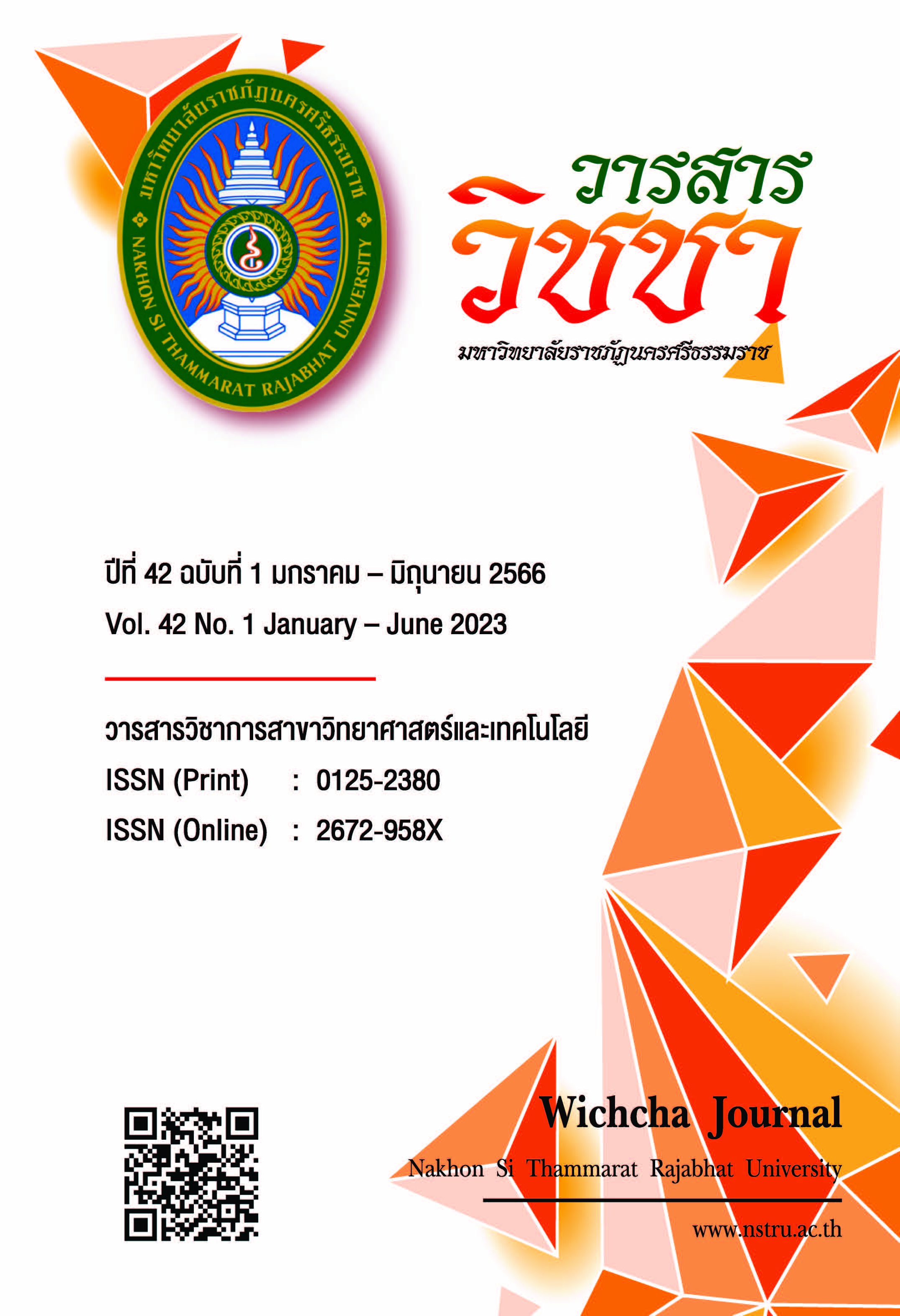Fuel Properties of Biomass Briquettes and Biochar Briquettes from Santol and Mangosteen Peels
Main Article Content
Abstract
The research aimed to study the fuel properties of biomass briquettes and biochar briquettes from santol and mangosteen peel. The biomass briquettes were prepared through the drying process, and biochar briquette were prepared through the carbonization from smokeless kiln. Both types of fuels were finely grinded and extruded to solid cylindrical rods with a binder from using tapioca starch, water and fuel materials with a ratio of 80:700:1,000 by weight. The thermal energy, chemical properties, and mechanical properties have been measured. The results showed that both biomass briquettes and biochar briquettes from mangosteen peels have higher energy values than those from santol peels which corresponds to the chemical analysis including moisture content, ash content, volatile matter content, and fixed carbon value. For the mechanical properties of both biomass briquettes and biochar briquettes have a density and a fracture index which are suitable for transportation. The burning time and the fuel consumption are propitiated to produce fuel for household and community. In addition, it is the use of waste materials from nature for the benefit of energy.
Article Details

This work is licensed under a Creative Commons Attribution-NonCommercial-NoDerivatives 4.0 International License.
เนื้อหาและข้อมูลในบทความที่ลงตีพิมพ์ในวารสารวิชชา มหาวิทยาลัยราชภัฏนครศรีธรรมราช ถือเป็นข้อคิดเห็นและความรับผิดชอบของผู้เขียนบทความโดยตรง ซึ่งกองบรรณาธิการวารสารไม่จำเป็นต้องเห็นด้วยหรือร่วมรับผิดชอบใด ๆ
บทความ ข้อมูล เนื้อหา รูปภาพ ฯลฯ ที่ได้รับการตีพิมพ์ในวารสารวิชชา มหาวิทยาลัยราชภัฏนครศรีธรรมราช ถือเป็นลิขสิทธ์ของวารสารวิชชา มหาวิทยาลัยราชภัฏนครศรีธรรมราช หากบุคคลหรือหน่วยงานใดต้องการนำข้อมูลทั้งหมดหรือส่วนหนึ่งส่วนใดไปเผยแพร่ต่อหรือเพื่อการกระทำการใด ๆ จะต้องได้รับอนุญาตเป็นลายลักษณ์อักษรจากวารสารวิชชา มหาวิทยาลัยราชภัฏนครศรีธรรมราชก่อนเท่านั้น
The content and information in the article published in Wichcha journal Nakhon Si Thammarat Rajabhat University, It is the opinion and responsibility of the author of the article. The editorial journals do not need to agree. Or share any responsibility.
References
กฤษฎา บุญชม และนิลุบล ไชยสมปาน. (2563). การศึกษาถ่านอัดแท่งจากไม้ลำไย. วารสารนเรศวรพะเยา, 13(2), 51-56.
เตือนใจ ปิยัง อเนก สาวะอินทร์ และนฤทธิ์ กล่อมพงษ์. (2561). การผลิตเชื้อเพลิงอัดแท่งจากวัสดุเศษเหลือในสวนปาล์มน้ำมันบ้านห้วยยูง จังหวัดกระบี่. วารสารวิจัยเพื่อการพัฒนาเชิงพื้นที่, 10(5), 365-374.
ธนาพล ตันติสัตยกุล สุริฉาย พงษ์เกษม ปรีย์ปวีณ ภูหญ้า และภานุวัฒน์ ไถ้บ้านกวย. (2558). พลังงานทดแทนชุมชนจากเชื้อเพลิงชีวมวลอัดแท่งจากทางมะพร้าว. วารสารวิทยาศาสตร์และเทคโนโลยี, 23(3), 418-431.
ธเนศ ไชยชนะ จอมภพ แววศักดิ์ จตุพร แก้วอ่อน และอุษา อ้นทอง. (2557). สมบัติความเป็นเชื้อเพลิงของถ่านเปลือกมังคุด. วารสารมหาวิทยาลัยทักษิณ, 17(3), 29-36.
นฤภัทร ตั้งมั่นคงวรกูล. (2557). การผลิตแท่งเชื้อเพลิงจากวัสดุเหลือใช้ในอุตสาหกรรมการเกษตรและครัวเรือน. วารสารมหาวิทยาลัยศรีนครินทรวิโรฒ (สาขาวิทยาศาสตร์และเทคโนโลยี), 6(11), 66-77.
ลดาวัลย์ วัฒนะจีระ ณรงค์ศักดิ์ ลาปัน วิภาวดี ชัชวาล และอานันท์ ธัญญเจริญ. (2559). การพัฒนาก้อนเชื้อเพลิงชีวมวลจากเศษฟางข้าวผสมเศษลำไยเหลือทิ้ง. วารสารวิจัยและพัฒนา มจธ, 39(2), 239-255.
สุนันทา ข้องสาย. (2563). สภาวะที่เหมาะสมในการเตรียมและความสามารถในการดูดซับของถ่านกัมมันต์ที่ผลิตจากวัสดุเหลือใช้ในการผลิตใบจากมวนยาสูบ. วารสารวิชชา มหาวิทยาลัยราชภัฏนครศรีธรรมราช, 39(1), 46-57.
สำนักงานมาตรฐานผลิตภัณฑ์อุตสาหกรรม. (2547). มาตรฐานผลิตภัณฑ์ชุมชนของถ่านอัดแท่ง มผช. 238-2547. กรุงเทพฯ.
American Society for Testing and Materials (ASTM). (2002). Standard test method for moisture in the analysis sample of coal and coke: ASTM D3172-89. Pennsylvania: ASTM International.
American Society for Testing and Materials (ASTM). (2011). Standard test method for moisture in the analysis sample of coal and coke: ASTM D3173-11. Pennsylvania: ASTM International.
American Society for Testing and Materials (ASTM). (2011). Standard test method for moisture in the analysis sample of coal and coke: ASTM D3174-11. Pennsylvania: ASTM International.
American Society for Testing and Materials (ASTM). (2011). Standard test method for moisture in the analysis sample of coal and coke: ASTM D3175-11. Pennsylvania: ASTM International.


